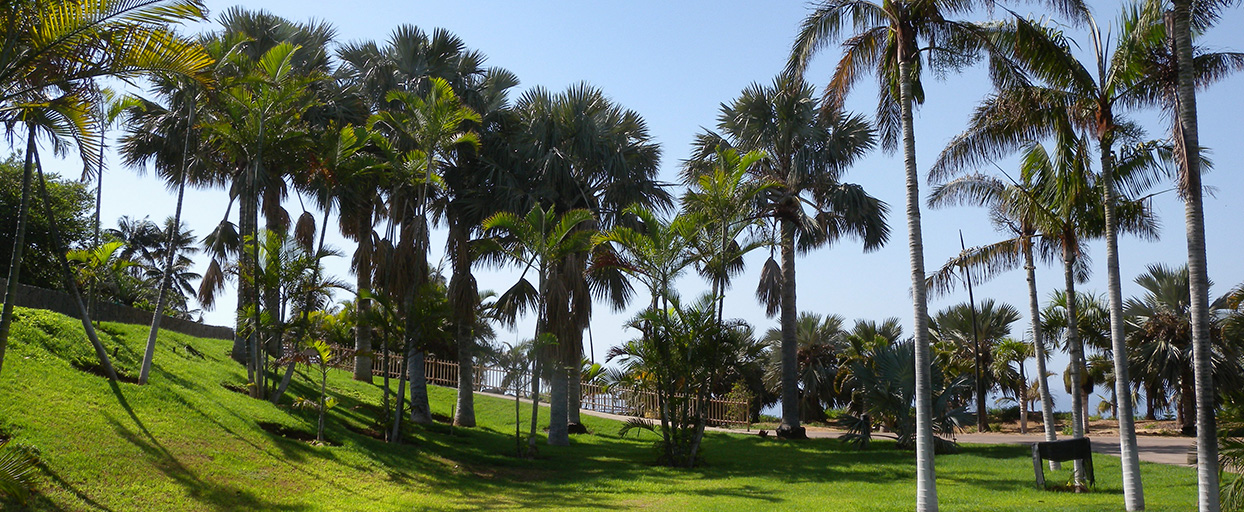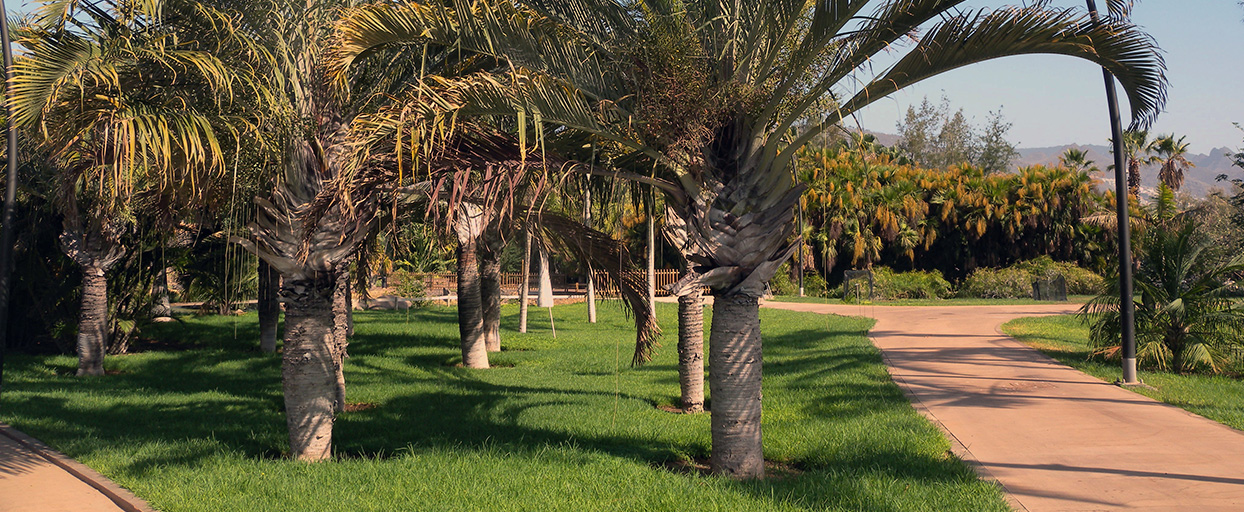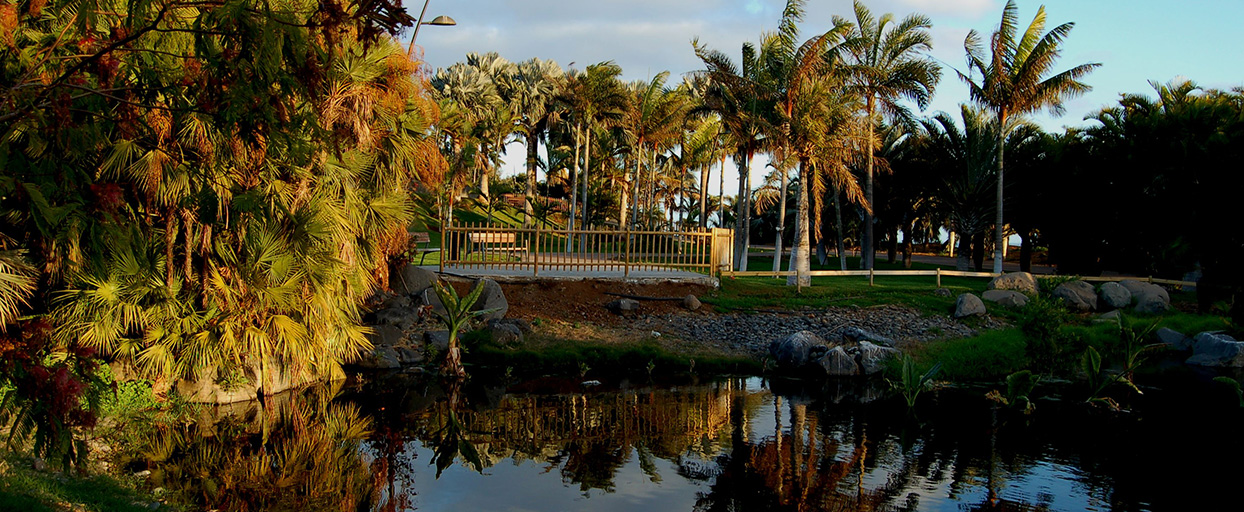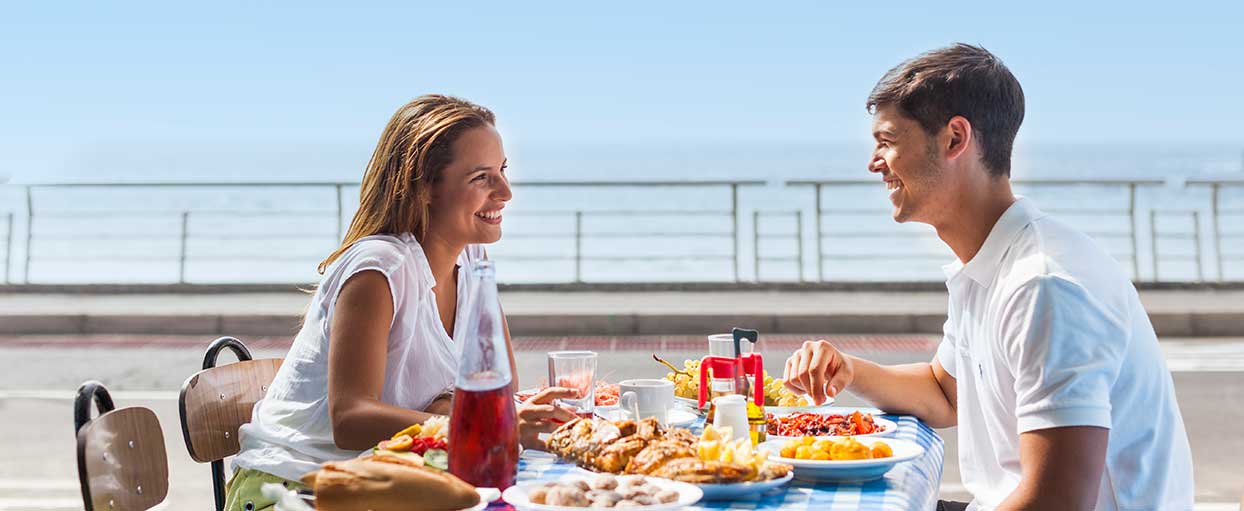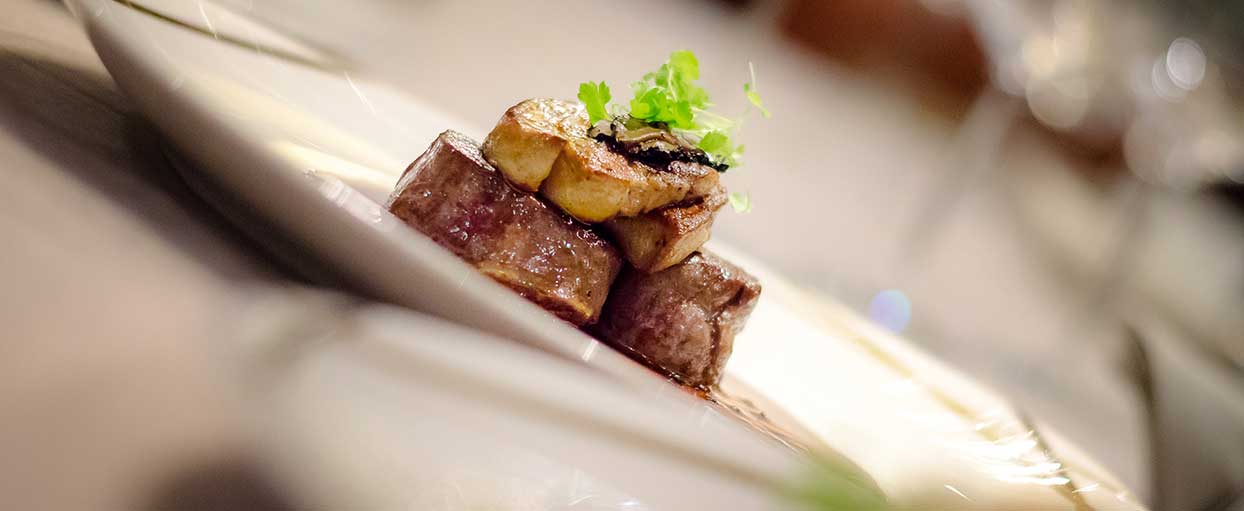This is a large Botanical Garden that was inaugurated in 2014, although its plants began to acclimatise themselves 20 years before it moved to its current location. Its 12 hectares of surface area contain more than 2,500 species of palm trees; of these, 70 are in danger of extinction, such as examples of Pancratium canariense.
Its was created after the closure of the city’s garbage dump in 1983, when there was a public debate about what to do with the mountain that contained the capital’s solid waste. In 1996, the agronomist Manuel Caballero suggested the idea of turning it into a palm grove and began to draft the project, together with the engineers José Luís Olcina and Juan Alfredo Amigó, initiating the work of planning roads and paths, covering the rubble with fertile soil, installing a gas extraction system consisting of wells, pumps and a flare to burn the gas off, etc.
The graduate in Fine Arts Carlos Simón was responsible for giving the construction project some character, which he did by lining the lakes, rivers and waterfalls with stones in the style of César Manrique. Thus the first 100 palm trees were planted and, once the first part of the work was finished, for a series of reasons the Palmetun was temporarily closed.
In the year 2000 the work was resumed and several species were added such as baobabs, pot-bellied palms, araucarias and mangroves under the command of Carlo Morici, until 2010 when the final part of the work was finished. On 28th January 2014, 18 years after having installed the first “plant”, Don Felipe and Doña Leticia, still the princes of Spain at the time, inaugurated the Palmetum.
For several years, the mountain has been colonized by a multitude of native birds that have found their natural environment here. None of them has been introduced by man, which shows how the Garden is working as a basis for the sustenance of birdlife. There are more than 40 types of birds that nest in or pass through the Garden during their migration. Common moorhens nest next to the lake in the Madagascar section, allowing themselves to be seen easily. Other striking birds that are easy to spot are hoopoes, kestrels and owls.
In the winter months, the lakes are visited by white herons and imperial herons. In addition to bird life, the various lakes feature Iberian frogs, miniature frogs and toads and, at different times of the year, beautiful American butterflies appear: the monarch.
The Palmetum is a sustainable area because only best cultivation practices are used, without herbicides or phytosanitary products. The ground is covered with crushed vegetable remains that stabilise the temperature. Specialized in the palm family (Arecaceae), it generates huge international scientific interest as it hosts one of the best collections of this botanical species in the world.
JOURNEY AROUND THE PALMETUM
1.- We enter the Palmetum on the North side, where species from the thermophilic forest near the city have been planted.
From this moment onwards we will see more than 2,500 species of palm trees; including Canarian, coconut, date, oil and climbing palms. Of these, 70 species are in danger of extinction, such as these examples of Pancratium canariense.
2.- In the gap in the slope on the left, you can see that the layer of fertile land only has a depth of 1 m and below it are all kinds of waste, as this is an artificial mountain that was formed in the 70’s by the accumulation of the city’s garbage. As the fermentation of this waste continues to generate gas on the inside, 21 degassing wells are used to extract the gas from the core of the mountain and take it to a station where it is eliminated.
We call this a sustainable area because we do not use herbicides or phytosanitary products, pests are controlled by means of pressurized water washes and good cultivation practices and the soil is mulched with crushed vegetable remains to mitigate the temperature, provide nutrients and save on irrigation water; by the way, the black plastic pipe that you can see is the one that carries the reclaimed water coming from the city’s wastewater treatment plant.
3.- These low-growing and branched palm trees, called Serenoa, are famous because a remedy to cure prostate cancer can be extracted from their fruits.
4.- These examples of Noni come from Polynesia where the juice of its fruits is used for medicinal purposes due to its antioxidant, anti-carcinogenic and analgesic properties.
5.- This gigantic tree that has orange flowers with yellow stamens, called Madagascar Baobab, is one of the few species that exist in the world. It starred in the novel The Little Prince.
6.- In Madagascar Lake you can see that the trees that are in the water have roots in the shape of stilts, called mangroves, which are famous for having created islands in South America.
In this lake there are common moorhens, birds that nest amongst the roots of the mangroves because the Palmetum is the habitat of other birds such as alpispas, swallows, blackbirds, parrots, and even migratory species such as imperial herons, etc.
7.- So that these swamp palms from Florida feel at home, twice a week the river is allowed to overflow to submerge their roots.
8.- These unusual South American trees called drunken sticks, which have thick trunks widened at their base with a thorny bark adorned with green longitudinal striations, produce beautiful flowers which are followed by large green fruits that open out into five leaflets containing a kind of cotton that is used for thermal insulation.
9.- These small palm trees known as Guano, which has leaves that are rigid with a silver underside and a very decorative crown, were the inspiration for the Palmetum’s logo.
10.- These two specimens of Palmera Princesa are the most beautiful and majestic at the Palmetum. Although both were planted in 1997, they are different because the thinnest came from Florida already grown and had a hard time adapting; however, the other one was planted when it was very small and grew perfectly. The rings on their trunks do not correspond to their age – they are the scars left by each leaf that has fallen. To calculate its age you need to consider that each year it produces 5 to 8 leaves.
11- Mirador del Caribe (Carribean viewpoint)
The mountains in the background are part of the Anaga massif, which has been declared a Biosphere Reserve as it is a living relic of the tertiary era, formed by a subtropical laurisilva forest in which different species of birds nest.
The forest owes its subsistence to the mists full of humidity carried by the trade winds, called a sea of clouds, in which the leaves act as sponges trapping the water that soaks the ground and refills the aquifers, which in Tenerife are called galleries, from which we supply ourselves with this liquid element.
12 .- Now we see the princess of the royal palm trees, a Jamaican species planted by the King and Queen of Spain when they were princes on the day the Palmetum was inaugurated, on 28th January 2014.
13.- The coconut tree is the easiest palm tree to recognize. It lives on sandy beaches and grows with its trunk curved towards the sea so that the fruits fall into the water, float away and their seeds can colonize new beaches.
14.- On the right side of the road you will see two specimens of Cuban pot-bellied palm, with thorns in their leaves and along the whole of their trunks.
At the curve there are several specimens of Dominican palm trees, called vinifera because a material can be extracted from their belly that looks like wine when it is fermented.
15.- These are African oil palm trees, one of the most cultivated plants on the planet because from the pulp of its fruit comes the oil that is used for the manufacture of margarine, toothpaste, cosmetics, lubricants, candles, etc. From its seeds palm kernel oil can be extracted, which is used for the manufacture of soap.
This is the oil that is used in most industrial bakery products, with a negative impact on our cholesterol.
16.- These large palm trees with a very dark leaf base are called Borassus. They reach a height of 25 m and are used in construction because they are not attacked by termites. It is the favourite tree of elephants because they can scratch their back on its rough trunk and they enjoy eating its fruits with the result that, when they defecate, the seeds are spread to other locations.
17.- Here we can see the sugar palm, which have very short trunks and leaves that are more than 10 m long. When they turn 20 years old they bloom, fructify and die.
18.- The foxtail palm tree, recently discovered in the north of Australia, is named for the appearance of its leaves, with one main nerve and several nerves on the sides of it. It is very well appreciated in gardening and in this city there are a lot of specimens because they have adapted well to our subtropical climate.
19.- The Palmetum also has banana trees, although they do not belong to the family of palm trees. The red bananas that you can see are very rich in vitamin A.
20.- The Tahina palm tree was first discovered in 2007 in Madagascar and its seeds were donated to us by Kew Botanical Garden in London. It has a fan shape and its leaves emerge on both sides of the stem, in two rows.
21.- This area protected by walls and shading is called the Octogon – it was designed in this way to house the most delicate species whilst protecting them from large variations in temperature and the wind. Its interior is divided into plants from the New and Old Worlds. It has two waterfalls made of volcanic rock. The jewel of the octagon is the climbing palm trees, whose seeds came from Mexico.
[/tabitem] [tabitem]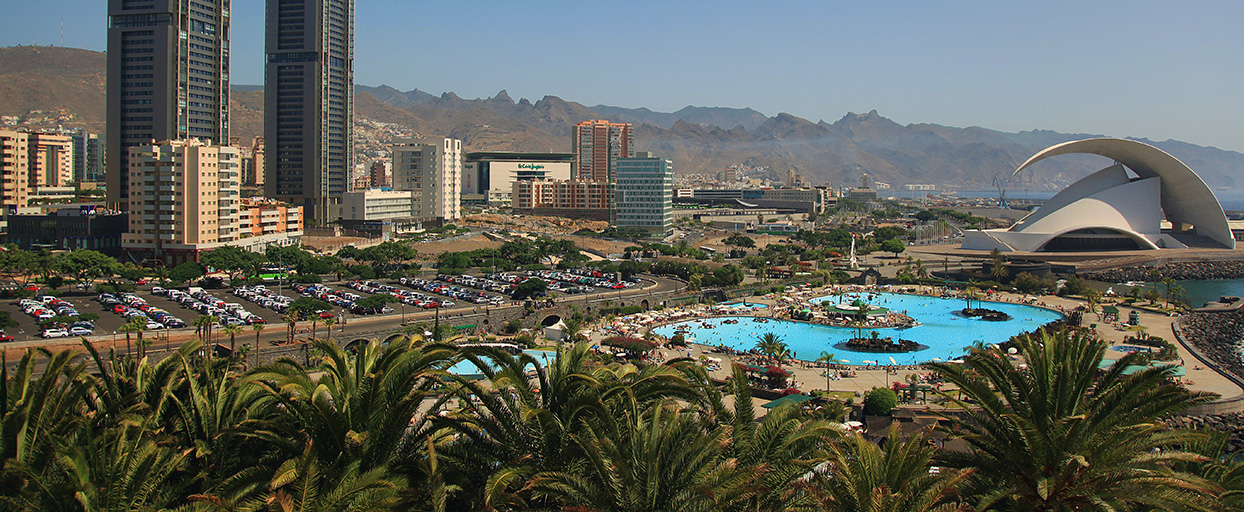
[/tabitem]
[tabitem]
SHOPPING:
With an average temperature of 21 degrees all year round, Santa Cruz is the perfect place to shop in the most extensive open shopping area of the island. Small shops and big brands mingle in an outdoor setting where locals and visitors turn shopping into a unique experience. There is a great variety of shops, cafés, bars, and restaurants to spend a pleasant day browsing and relaxing. The city has the best boutiques and international brands with the latest fashion trends on display in their shop windows. Throughout the city’s shopping streets, large department stores and shopping malls coexist with traditional, small shops where a personal shopping experience and product quality are in the forefront. All of this is wrapped up in a pleasant, friendly atmosphere that makes you want to stroll along the city’s streets, parks, squares and gardens and to sit down to have a drink at any of its many bar terraces.
The shops’ and restaurants’ closeness to each other turns visiting Santa Cruz into a unique experience. The city is easy to access and equipped with enough parking and public transport services: trams, buses, and taxis.
We suggest you see the city by taking some of the following shopping routes:
Route 1 City Centre: Calle Pérez Galdós, calle Viera y Clavijo, calle Méndez Núñez, calle Pi y Margall, calle Suárez Guerra, calle El Pilar, shopping centre “Centro Comercial Parque Bulevar”, calle La Rosa and nearby streets. Enjoy this shopping experience in an area where you can find all kinds of stores offering clothing, accessories, footwear, jewellery, watches, perfumes… This route contains a great number of boutiques showcasing leading brands, with exquisite service and a wide range of unique designs.
Route 2 City Centre: Plaza de La Candelaria, calle Castillo, calle Imeldo Serís, calle Valentin Sanz, calle Bethencourt Alfonso and nearby streets. In the heart of the city you will find the street calle Castillo, a traditional shopping street with all kinds of international franchises and fashion retail chains. The route follows this street, which begins in Plaza de Candelaria and ends at Plaza Weyler.
Route Ramblas: Plaza Weyler, Rambla Pulido, Rambla de Santa Cruz and nearby streets. This route is characterized by a concentration of the commercial activity around both Ramblas: Rambla de Santa Cruz and Rambla de Pulido. There you will find a wide range of shops characterized by the kind service and the quality of products. Along the Rambla de Santa Cruz you can enjoy an exhibition of Sculptures in the Street, which makes the shopping experience much more enjoyable.
Route Shopping Centres: This route is characterized by the presence of large department stores and shopping malls around which one can find a wide array of smaller shops and restaurants to suit all tastes. The main streets are Avenidas Tres de Mayo and Manuel Hermoso Rojas, calle Álvaro Rodríguez López, calle Aurea Díaz Flores and Avenida La Salle. Along this route you can enjoy a wide variety of leisure opportunities inside the shopping centres (cinema, restaurants and personal services) as outdoors (Auditorio de Tenerife Adán Martín, Recinto Ferial de Tenerife, Parque Marítimo César Manrique and Palmetum).
Route Market “Nuestra Señora de Africa”: La Recova, Rambla Azul, shopping centre Recova and Rastro de Santa Cruz (only Sundays). The Market’s shopping area is one of the busiest commercial districts on Santa Cruz. Its central nucleus is the Market of Santa Cruz de Tenerife, or La Recova. It has been open since 1944 and is the successor of the Old La Recova, which goes back to the 19th century. Here you can find the freshest foods from the Canary Islands and from all over the whole world. It specializes in fruit and vegetables, meats and fish, although you can purchase all sorts of foods there, as well as typical products.
The Neo-Colonial building that houses La Recova, is arranged over two large floors, with open patios where you can take a pleasant stroll and enjoy admiring the great variety of fresh foods for sale. Inside you will find a Café with terrace, a place to rest and enjoy food and all types of drinks. Opening hours of the Market Nuestra Señora de Africa are Monday to Saturday from 06 a.m. to 2:00 p.m., and Sundays from 7:00 a.m. to 2:00 p.m.
Next to the market you will find La Rambla Azul, its opening hours are from Monday to Sunday 9 a.m. to 2 p.m. There is also the Shopping Center with more than 40 shops and cafeterias, it opens from Monday to Saturday 9 a.m. to 9 p.m. and Sundays from 9 a.m. to 3 p.m.
Sundays morning are the days that the ‘Rastro,’ the large street market of Santa Cruz, is held at Avenida José Manuel Guimerá, surroundings of the open market Recova and Calle Bravo Murillo. Here you can find a great variety of first and second hand articles, antiques, clothes and fashion accessories in a festive and friendly environment.
GASTRONOMY:
Santa Cruz is the heart of Tenerife and as such it is the home of a range of food and drinks. All parts of the world are represented in the municipality. It’s a place where the food sector has experienced a remarkable growth in the last few years and the zone is known for being a metropolitan area that is home to two stars from the prestigious Michelin Guide.
The gastronomy is undoubtedly part of the local character of a culture. In this sense, the Canary Islands can proudly say that their cuisine is both simple and original in nature and that this is true in terms of the choice of ingredients and how dishes are prepared, with the Islands’ cuisine being based on the Guanche heritage, but also having a clear Spanish influence.
However, despite its simplicity, traditional Canarian cuisine is authentic and rich in flavours that give it a personality of its own – a personality that has been influenced by the Island Chain’s climate and the use of the products readily available in its sea and on its land.
Among the ingredients of traditional Canarian cuisine, some of the most important are products from the sea, such as fish and shellfish like the “vieja” (Mediterranean parrotfish), a white fish with a mild flavour, the “choco” (cuttlefish), a type of squid with a larger size, and the “cherne” (wreckfish), a fish that is consumed salted or as a stew.
In terms of foods from the land, the sweet potato and the potato are the indisputable companions to meat and fish, with the potato being famous in its “papas arrugadas” form (“Canarian wrinkly potatoes” – boiled potatoes with their skins left on). Vegetables such as the tomato, onion, garlic, varieties of peppers, squash, zucchini (or “bubango”), watercress, coriander, and parsley can be used in soups, stews, and in the preparation of the famous Canarian “mojo” sauce in its two versions: green (containing coriander) and red (“mojo picón,” containing pepper).
In terms of meats, noteworthy are dishes based on pork, rabbit, and kid goat, all of which can be prepared with a sauce as a stew, fried, or roasted.
Goat’s milk is the basic ingredient of the cheeses from the Canary Islands, which are consumed fresh, semi-cured, cured, and even smoked.
But there is a Canarian food product that is derived from grains like corn, wheat, and barley and which has become established as a “symbol” of the gastronomic culture of the islands. It is known as “Gofio” (a fine mixture of the aforementioned grains previously toasted and ground) and it has multiple culinary applications, as it has acted as the “bread of the canaries” (kneaded with water and not cooked), it can be consumed “scrambled” with broth (escaldón) or a stew, and it can even be mixed with honey and almonds to act as a desert. Its consumption is so widespread that, in many homes, it is customary to mix gofio with milk and sugar and use it for breakfast. Other products that complement the cuisine of the Canary Islands are the local wines from the region, with Tenerife being the perfect example. The island is divided into five wine-producing districts, and Santa Cruz de Tenerife is located in the Tacoronte-Acentejo district. Tenerife’s gastronomy brings together the products and dishes that are most representative of Canarian cuisine with a wide range of dining establishments.
One of the increasingly popular trends over the past few years is the diversification of traditional cuisine, giving rise to a new, more creative and contemporary branch of cooking known as “signature cooking.” While this type of cuisine keeps its base through the use of traditional products, it innovates by introducing new and exotic ingredients (many of them foreign) and a mix of flavours that bring originality to the recipe. Likewise, emphasis is placed on the dishes’ presentation, turning them into artistic creations done by expert chefs.
The dining sector of the municipality of Santa Cruz de Tenerife has it all. Visitors can find the best of the traditional cuisine mostly in restaurants or “guachinches” around the Anaga area. In the rest of the city, there are establishments that offer everything from traditional Canarian cuisine to exquisite “signature cooking” and more creative dishes, without forgetting the wide range of regional Spanish specialties, bars serving “tapas,” and a great variety of restaurants that offer international cuisine.
[/tabitem][/cq_vc_tabs]

